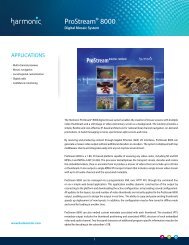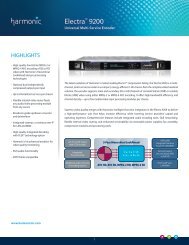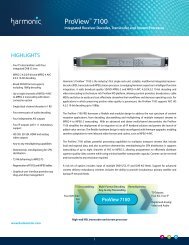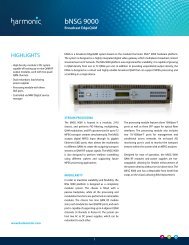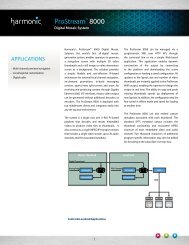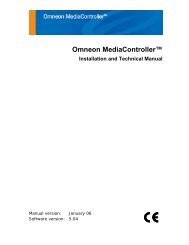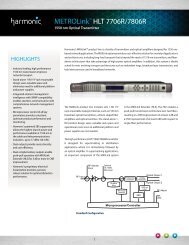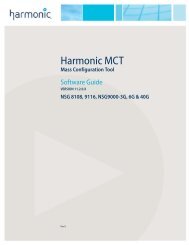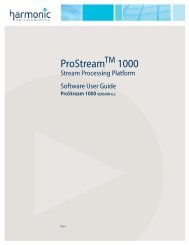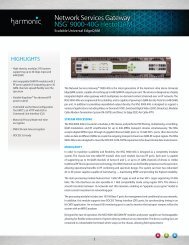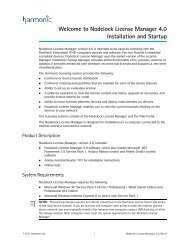NSG 9000-6G - Harmonic Inc
NSG 9000-6G - Harmonic Inc
NSG 9000-6G - Harmonic Inc
You also want an ePaper? Increase the reach of your titles
YUMPU automatically turns print PDFs into web optimized ePapers that Google loves.
Chapter 3 Configuring Platform Parameters<br />
EdgeCluster<br />
Table 3-14: EdgeCluster M-CMTS Versus Broadcast<br />
Item Deployment Difference<br />
GbE Input<br />
Ports<br />
Broadcast The GbE input ports of both <strong>NSG</strong> devices must be<br />
configured the same. However, each device should have a<br />
unique IP address of the input port.<br />
Redundancy<br />
Switch<br />
M-CMTS<br />
M-CMTS<br />
The GbE input ports of both <strong>NSG</strong> devices must be<br />
configured the same including the IP addresses of the GbE<br />
input ports.<br />
Note: For proper edgeCluster operation, GbE ports of the primary<br />
and backup devices should have fiber SFPs.<br />
Upon redundancy switch, the active device momentarily<br />
shuts up its GbE ports to signal the source device that the<br />
device is faulty.<br />
3.17.1.1 Triggering Event for Redundancy Switch<br />
The trigger for a redundancy switch can be one of the following:<br />
• A triggering alarm is raised on the active device. To view the list of the default triggering<br />
alarms and to define triggering alarms, see 6.3.5 Setting Alarm Parameters on page 123.<br />
NOTE: Only Advanced users may re-define the triggering alarms.<br />
• A manual redundancy switch, when Redundancy mode is Manual. See 3.17.2 Configuring<br />
EdgeCluster on page 69.<br />
• The standby device does not receive heartbeat messages for a pre-defined period of<br />
time due to a re-boot failure of the active device.<br />
3.17.1.2 Redundancy Switch Scenario<br />
Both devices constantly send and listen for heartbeat messages. Once a triggering event<br />
takes place on the primary/active device, the following takes place:<br />
• The primary/active device closes its QAM-RF ports and reflects its new status to its peer<br />
device via a heartbeat message.<br />
• The standby/ backup device becomes active, opens its QAM-RF ports and starts<br />
transmitting the content.<br />
NOTE: In case of a reboot failure of the active device, once it is back and running, it runs in Standalone<br />
mode.<br />
3.17.2 Configuring EdgeCluster<br />
NOTE: MCT is the main tool for configuring and controlling devices working in edgeCluster mode. The<br />
following descriptions and instructions refer to the web client of the device. To work with MCT, see MCT<br />
11.1 Software Guide.<br />
© 2012 <strong>Harmonic</strong> <strong>Inc</strong>. 69 <strong>NSG</strong> <strong>9000</strong>-<strong>6G</strong>, Version 2.7, Rev B



